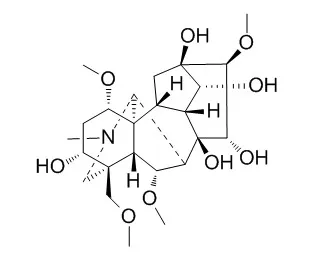| Description: |
Mesaconine has cardiac effect, it also has anti-NF-κB activity. Mesaconine may be part of material basis of Mahuang Fuzi Xixin decoction on anti-inflammation and immune suppression. |
| Targets: |
IL Receptor | NF-kB | IkB | Immunology & Inflammation related | IKK |
| In vitro: |
| J Ethnopharmacol. 2016 Dec 24;194:658-667. | | Identification of NF-κB inhibitors following Shenfu injection and bioactivity-integrated UPLC/Q-TOF-MS and screening for related anti-inflammatory targets in vitro and in silico.[Pubmed: 27771457] | Shenfu injection (SFI) is a commercial medicinal product approved by the China Food and Drug Administration that is widely used in the treatment of stroke and coronary heart disease. However, the material basis and the mechanism of SFI are not fully understood. With network pharmacology analysis, our research committed to identify the anti-inflammatory ingredients and mechanism of SFI by combining high-throughput screening.
METHODS AND RESULTS:
We developed a bioactivity-based UPLC/Q-TOF-MS method followed by network pharmacology and identified the anti-inflammatory active ingredients of SFI from two different perspectives of network computing and high throughput screening. Then we verified the anti-inflammatory effect of SFI in vitro with endothelial cells. After detecting the cell viability, the expression of interleukin-6 (IL-6), inhibitor of nuclear factor kappa-B kinase (IKK), phosphorylated IKK, phosphorylated NF-κB and phosphorylated IκB-α from the supernatant were determined. RESULTS: SFI could significantly suppress inflammatory responses, and the mechanism may be via an NF-κB-dependent pathway. The results of high throughput screening (HTS) revealed that protopanaxadiol glycosides (ginsenosides Rb1, Rb2, Rb3, Rc and Rd), protopanaxatriol glycosides (ginsenosides Rg1, Rg2, Re, Rf and F1), diester-type alkaloids (fuziline and neoline) and aconine derivatives (Mesaconine and benzoyl-Mesaconine) have anti-NF-κB activity. The three compounds (including benzoyl-Mesaconine, fuziline and neoline) are the first reported SFI compounds to have NF-κB inhibitor activity.
CONCLUSIONS:
SFI may play a critical role in counteracting inflammation through the NF-κB signaling pathway. The active ingredients are protopanaxadiol glycosides, protopanaxatriol glycosides, diester-type alkaloids and aconine derivatives. |
|
| In vivo: |
| Xenobiotica. 2017 Dec 27:1-9. | | The in vivo pharmacokinetics, tissue distribution and excretion investigation of mesaconine in rats and its in vitro intestinal absorption study using UPLC-MS/MS.[Pubmed: 29228872] | 1. Mesaconine, an ingredient from Aconitum carmichaelii Debx., has been proven to have cardiac effect. For further development and better pharmacological elucidation, the in vivo process and intestinal absorptive behavior of Mesaconine should be investigated comprehensively.
METHODS AND RESULTS:
2. An ultra-high performance liquid chromatography-tandem mass spectrometry (UPLC-MS/MS) method was developed and validated for the quantitation of Mesaconine in rat plasma, tissue homogenates, urine and feces to investigate the in vivo pharmacokinetic profiles, tissue distribution and excretion. The intestinal absorptive behavior of Mesaconine was investigated using in vitro everted rat gut sac model.
3. Mesaconine was well distributed in tissues and a mass of unchanged form was detected in feces. It was difficultly absorbed into blood circulatory system after oral administration. The insufficient oral bioavailability of Mesaconine may be mainly attributed to its low intestinal permeability due to a lack of lipophilicity.
CONCLUSIONS:
The absorption of Mesaconine in rat's intestine is a first-order process with the passive diffusion mechanism. | | Zhongguo Zhong Yao Za Zhi. 2015 May;40(10):1971-6. | | Study on material basis of Mahuang Fuzi Xixin decoction for anti-inflammation and immune suppression based on combined method of serum pharmacochemistry and serum pharmacology.[Pubmed: 26390658] | To investigate me material basis of Mahuang Fuzi Xixin decoction (MFXD) for anti-inflammation and immune-suppression based on the combined method of serum chemical and serum pharmacological.
METHODS AND RESULTS:
The LC-MS/MS fingerprints of MFXD, drug-containing serum and blank serum were compared to define the components in plasma.
Histamine, β-hexosaminidase released from RBL-2H3 cell infulenced by drug-containing serum at different time points were measured by ELISA. The effect of drug-containing serum on lipopolysaccharide-induced splenocyte proliferation at different time points were determined by MTT. A correlation analysis was made on components of MFXD and pharmacological indexes based the stepwise regression method. After the intragastrical administration with MFXD, 32 components were discovered in rat serum, including 27 prototype components (10 from Mahuang, 13 from Fuzi and four from Xixin) and five unknown components. Compared with blank serum, drug-containing serum could reduce the release of histamine from RBL-2H3 induced by antigen at different time points (P < 0.05); except the 4-hour drug-containing serum, all of the remaining drug-containing serums could inhibit the RBL-2H3 mastocyte degranulation induced by antigen at different time points (P < 0.05). Drug-containing serum could significantly lipopolysaccharide-induced mouse splenocyte proliferation at 15 and 30 min (P < 0.05). A regression analysis was made on the chemical data of components absorbed into blood and pharmacological indexes, i. e. release rate of histamine, release rate of β-hexosaminidase and inhibition rate of splenocyte.
CONCLUSIONS:
This suggested the close correlations among methyl pseudo-ephedrine, pseudoephedrine and histamine released from RBL-2H3 induced by antigen; pseudoephedrine, hypaconine, methyl pseudoephedrine and β-hexosaminidase released from RBL-2H3 induced by antigen; as well as benzoyl hypaconine, benzoylaconine, 14-benzoyl-10-OH-Mesaconine, Mesaconine and lipopolysaccharide-induced mouse splenocyte proliferation. Methylpseudoephedrine, pseudoephedrine, benzoyl hypaconine, benzoylaconine and Mesaconine may be part of material basis of MFXD on anti-inflammation and immune suppression. |
|






 Cell. 2018 Jan 11;172(1-2):249-261.e12. doi: 10.1016/j.cell.2017.12.019.IF=36.216(2019)
Cell. 2018 Jan 11;172(1-2):249-261.e12. doi: 10.1016/j.cell.2017.12.019.IF=36.216(2019) Cell Metab. 2020 Mar 3;31(3):534-548.e5. doi: 10.1016/j.cmet.2020.01.002.IF=22.415(2019)
Cell Metab. 2020 Mar 3;31(3):534-548.e5. doi: 10.1016/j.cmet.2020.01.002.IF=22.415(2019) Mol Cell. 2017 Nov 16;68(4):673-685.e6. doi: 10.1016/j.molcel.2017.10.022.IF=14.548(2019)
Mol Cell. 2017 Nov 16;68(4):673-685.e6. doi: 10.1016/j.molcel.2017.10.022.IF=14.548(2019)